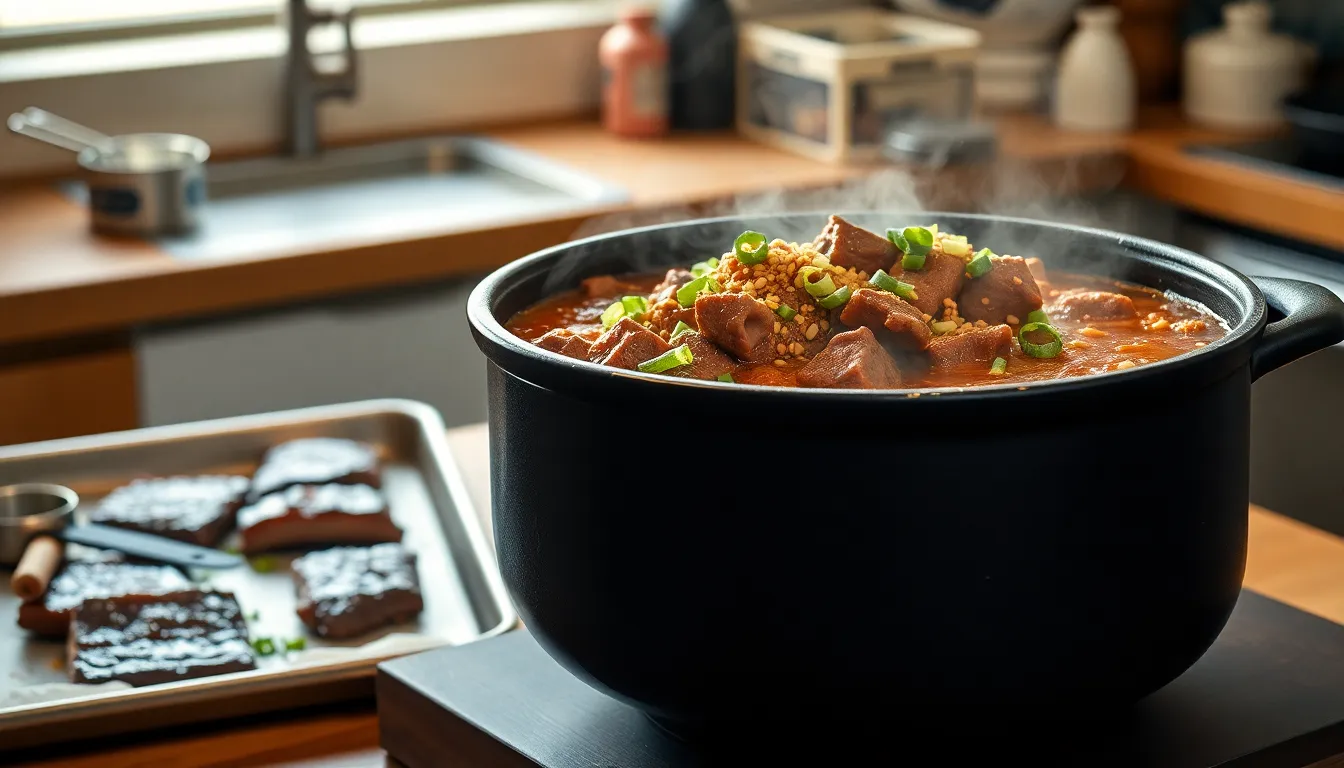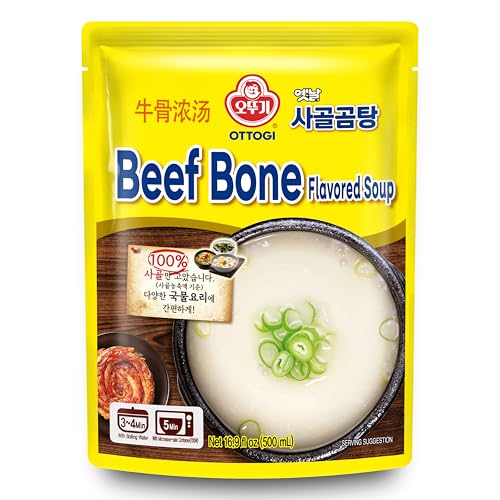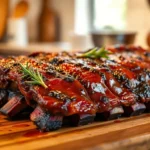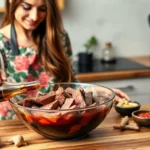Nothing beats the comfort of a steaming bowl of Korean beef stew on a cold day. This hearty dish combines tender chunks of beef with aromatic vegetables in a rich, savory broth that’ll warm you from the inside out. We’ve perfected this traditional recipe to bring authentic Korean flavors straight to your kitchen.
Korean beef stew isn’t just another soup – it’s a complete meal that showcases the beautiful balance of sweet, salty, and umami flavors that Korean cuisine is famous for. The secret lies in the slow-cooking process that transforms tough cuts of beef into melt-in-your-mouth perfection while infusing every ingredient with incredible depth of flavor.
We’ll show you how to create this soul-satisfying stew using simple ingredients you can find at most grocery stores. Get ready to impress your family with a dish that’s both nutritious and absolutely delicious.
Ingredients
We’ve carefully selected each ingredient to create the perfect balance of flavors in our Korean beef stew. These components work together to build layers of taste that make this dish truly special.
For the Beef
- 2 pounds beef chuck roast, cut into 2-inch cubes
- 1 tablespoon vegetable oil
- 1 teaspoon salt
- 1/2 teaspoon black pepper
For the Vegetables
- 2 large Korean radish (mu), peeled and cut into 2-inch chunks
- 1 large onion, cut into thick wedges
- 4 cloves garlic, minced
- 1 piece fresh ginger (2 inches), sliced thin
- 2 green onions, cut into 2-inch pieces
- 1 medium carrot, cut into thick rounds
For the Seasoning and Broth
- 3 tablespoons soy sauce
- 2 tablespoons Korean soup soy sauce (guk ganjang)
- 1 tablespoon mirin
- 1 teaspoon sesame oil
- 6 cups beef broth
- 2 cups water
- 1 tablespoon Korean chili flakes (gochugaru)
- 1 teaspoon sugar
- 1/2 teaspoon ground white pepper
Equipment Needed

Creating authentic Korean beef stew requires exact equipment that ensures proper cooking techniques and optimal flavor development. We recommend gathering these essential tools before beginning your cooking process.
Large Heavy-Bottom Pot or Dutch Oven serves as the foundation for our Korean beef stew preparation. This versatile piece allows us to brown the meat effectively and maintain consistent heat during the slow braising process. The heavy bottom prevents hot spots and ensures even cooking throughout the 3-hour braising period at 325°F.
Sheet Pan becomes necessary when we want to create that signature glazed finish on our beef short ribs. After the initial braising process we transfer the meat to a sheet pan for high-heat roasting at 425°F to develop the sticky caramelized exterior.
Oven provides the consistent temperature control essential for proper braising. We rely on oven heat rather than stovetop cooking to maintain the steady 325°F temperature needed for tender meat that falls apart easily.
Food Processor or Blender streamlines the sauce preparation process by efficiently combining garlic, ginger, soy sauce, and mirin into a smooth mixture. When these appliances are unavailable we can substitute with a grater or microplane to achieve finely minced aromatics.
Basic Preparation Tools complete our equipment list and include measuring cups and spoons for accurate ingredient portions, a sharp knife and cutting board for vegetable preparation, and a sturdy spoon or spatula for stirring and glazing operations.
Serving Bowls allow us to present our finished Korean beef stew with proper garnishes of scallions and sesame seeds. The right serving vessel enhances the dining experience and showcases the rich colors of our completed dish.
This equipment setup provides everything necessary for creating traditional Korean beef stew varieties like Galbi Jjim or Bulgogi Jeongol with restaurant-quality results in your home kitchen.
Prep Work

Setting up our workspace and preparing each component properly ensures our Korean beef stew develops the deep flavors and tender texture that make this dish exceptional. We’ll organize our preparation into three essential stages that build the foundation for authentic taste.
Preparing the Beef
We start by blanching our beef short ribs or chuck roast pieces in boiling water for about 10 minutes to remove impurities and create a cleaner-tasting broth. After blanching, we drain and rinse the meat thoroughly under cold water to wash away any remaining foam or debris.
Next, we heat our Dutch oven over medium heat and brown the beef pieces in batches, ensuring each piece develops a deep caramelized crust that adds rich flavor to our stew. Once we’ve browned all the beef, we set it aside and use the same pot to caramelize our aromatics.
We sauté minced garlic, sliced onions, and fresh ginger in the beef drippings until fragrant and golden. This step captures all the fond from browning the meat while building our flavor base. After returning the beef to the pot, we add our braising liquid and seasonings to begin the slow cooking process.
Preparing the Vegetables
We peel and cut our carrots into large chunks that will hold their shape during the long braising time. Our daikon radish gets cubed into uniform pieces to ensure even cooking throughout the stew.
Timing matters when adding vegetables to prevent overcooking. We wait until our beef has braised for about halfway through its cooking time before introducing the prepared vegetables to the pot. This approach ensures both the meat and vegetables reach perfect tenderness simultaneously.
We add the carrots and daikon radish to the pot when the beef begins to soften, typically after 1 to 1.5 hours of braising. The vegetables will simmer for an additional 15 to 45 minutes until they become tender while maintaining their texture.
Making the Marinade
We combine soy sauce, mirin, minced garlic, grated ginger, and grated onion in a mixing bowl to create our base braising liquid. Brown sugar or honey adds the essential sweetness that balances the salty and umami elements.
For authentic Korean flavor, we whisk in gochujang (Korean chili paste) and rice wine to our marinade mixture. This combination creates the signature sweet, salty, and spicy profile that defines Korean beef stew.
We can enhance the marinade with grated Asian pear or apple for natural sweetness and additional gochugaru (Korean red chili flakes) for extra heat. The completed marinade gets poured over our beef before braising, allowing the meat to absorb these complex flavors during the slow cooking process.
Instructions

Now we’ll transform our carefully prepared ingredients into a rich and aromatic Korean beef stew. The cooking process involves five essential steps that build layers of flavor while ensuring the beef becomes perfectly tender.
Marinating the Beef
We begin by creating a flavorful marinade that will infuse our beef with authentic Korean taste. Mix together 2 tablespoons of miso paste, 3 tablespoons of gochujang, 1/4 cup of soy sauce, 4 minced garlic cloves, 2 tablespoons of fresh grated ginger, and 3 tablespoons of mirin in a large bowl. Place the beef pieces in this marinade and coat them thoroughly with the mixture. Cover the bowl and refrigerate for 4 to 12 hours, allowing the flavors to penetrate deep into the meat. The longer marinating time creates more complex flavors that will enhance our final dish.
Browning the Beef
We heat 2 tablespoons of canola oil in our Dutch oven over medium-high heat until it shimmers. Remove the beef from the marinade and pat it dry with paper towels, reserving the marinade for later use. Working in batches to avoid overcrowding, we brown the beef pieces on all sides until they develop a deep caramelized crust, about 3-4 minutes per side. This browning process creates the Maillard reaction that adds rich, complex flavors to our stew. Transfer the browned beef to a plate and set aside, keeping the flavorful drippings in the pot.
Building the Stew Base
Using the same pot with our beef drippings, we sauté 1 large diced onion, 6 minced garlic cloves, and 2 tablespoons of fresh grated ginger until they become fragrant and lightly browned, about 3-4 minutes. Add 4 cups of beef broth, 1/4 cup of soy sauce, the reserved marinade, 2 tablespoons of mirin, and 1 cup of dried shiitake mushrooms to the pot. Bring this mixture to a rolling boil, then nestle our browned beef pieces back into the liquid with the meat side facing down. Cover the pot and transfer it to a preheated 325°F oven for approximately 3 hours, braising until the beef becomes fork-tender and easily shreds.
Adding Vegetables and Simmering
We carefully remove the tender beef from the pot and skim any excess grease from the surface of our stew base. Add 2 cups of diced daikon radish, 2 large carrots cut into 2-inch pieces, and 2 medium potatoes quartered to the simmering liquid. Return the stew to the stovetop and bring it back to a gentle simmer over medium heat. Partially cover the pot and cook for 15-45 minutes until the vegetables pierce easily with a fork. Monitor the vegetables closely as they may cook at different rates, removing any that finish early to prevent overcooking.
Final Seasoning Adjustments
We stir 2 tablespoons of mirin and 1 tablespoon of rice vinegar into our finished stew to brighten the flavors. Taste the broth and adjust the seasoning with additional salt, mirin, or vinegar as needed to achieve the perfect balance. For an optional glazed finish, brush the cooked beef with a mixture of gochujang and honey, then broil for 2-3 minutes until caramelized. Garnish our Korean beef stew with sliced green onions and toasted sesame seeds before serving over steamed rice.
Cooking Tips for Perfect Korean Beef Stew

Mastering Korean beef stew requires attention to key techniques that elevate this comfort dish from good to exceptional. We’ve gathered essential tips that ensure tender meat and perfectly balanced flavors every time.
Brown the meat thoroughly to develop deep richness in your stew. We recommend browning the beef in batches rather than overcrowding the pot. This caramelization creates the foundation for complex flavors that define authentic Korean beef stew.
Maintain slow and low cooking temperatures throughout the braising process. We braise our beef at 325°F for approximately 3 hours until the meat shreds easily with a fork. This extended cooking time transforms tough cuts into melt-in-your-mouth tenderness while allowing flavors to meld completely.
Skim the surface regularly during simmering to achieve a cleaner broth. We remove foam and excess fat that rises to the top every 15-20 minutes. This technique produces a clearer and more refined stew base.
Balance your flavor profile by incorporating all four taste elements. We combine salty soy sauce with sweet honey or mirin then add spicy gochujang and finish with a touch of vinegar for acidity. This harmony creates the signature taste that makes Korean beef stew so satisfying.
Invest in quality ingredients for noticeable improvements in taste. We always use fresh garlic and ginger rather than pre-minced versions. Good cuts of beef chuck or short ribs make a important difference in the final texture and flavor.
Time your vegetable additions carefully to prevent overcooking. We add hearty vegetables like carrots and daikon radish during the last 30 minutes of cooking. This timing keeps them tender but not mushy while absorbing the rich stew flavors.
Allow the stew to rest after cooking for deeper flavor development. We let our finished stew sit for 10-15 minutes before serving. This resting period allows the seasonings to settle and intensify throughout the dish.
Serving Suggestions

We recommend serving Korean beef stew hot in individual bowls to showcase the rich broth and tender ingredients. Each portion should feature a piece of the braised short rib or beef chuck placed prominently on top of the vegetables and broth.
Fresh garnishes elevate the presentation and add textural contrast to our hearty stew. We sprinkle chopped green onions generously over each serving for a bright pop of color and mild onion flavor. Toasted sesame seeds provide a nutty crunch that complements the tender beef perfectly.
Steamed white rice serves as the ideal accompaniment to absorb the flavorful broth and balance the richness of the stew. We place a bowl of rice alongside each serving to allow diners to enjoy both components together.
Traditional Korean side dishes enhance the overall dining experience by providing variety and palate cleansing elements. Kimchi offers a tangy, fermented contrast that cuts through the stew’s deep flavors beautifully. Other banchan like pickled vegetables or seasoned bean sprouts create a well-rounded Korean meal.
Light accompaniments help balance the stew’s intensity without overwhelming the main dish. We suggest serving mild steamed vegetables such as blanched spinach or steamed broccoli on the side. A simple mixed green salad with sesame dressing provides a refreshing counterpoint to the rich, warming stew.
The presentation should highlight the stew’s comfort food appeal while maintaining an elegant appearance. We ladle the stew carefully to distribute the beef, vegetables, and broth evenly in each bowl. The aromatic steam that rises from the hot serving bowls signals the warming, satisfying meal that awaits.
Storage and Reheating Instructions

After enjoying this comforting Korean beef stew, we want to ensure you can safely store and reheat leftovers to maintain both quality and flavor. Proper storage techniques will help preserve the rich broth and tender beef for future meals.
Proper Storage Methods
We recommend cooling the stew completely at room temperature before transferring it to storage containers. This prevents condensation from forming inside containers and maintains the stew’s texture. Transfer the cooled stew into airtight containers to prevent flavor loss and contamination.
Our Korean beef stew will stay fresh in the refrigerator for up to 3 to 4 days when stored properly. For longer storage periods, we suggest freezing the stew in freezer-safe containers or heavy-duty freezer bags for up to 2 to 3 months. Label each container with the preparation date to track freshness effectively.
Storage Duration Guidelines
| Storage Method | Duration | Container Type |
|---|---|---|
| Refrigerator | 3-4 days | Airtight containers |
| Freezer | 2-3 months | Freezer-safe containers or heavy-duty bags |
Reheating Instructions
We suggest thawing frozen stew overnight in the refrigerator before reheating to ensure even heating throughout. Reheat the stew on the stovetop over medium heat while stirring occasionally until it reaches an internal temperature of 165°F.
Add a splash of water or beef broth if the stew appears too thick after storage. The starches from potatoes and other vegetables may cause the broth to thicken during refrigeration. Alternatively, we can reheat portions in the microwave using a cover to prevent moisture loss and stirring halfway through the heating process.
Important Safety Guidelines
Never reheat the stew multiple times as this can compromise both safety and quality. We recommend consuming reheated stew within 24 hours of reheating. These practices ensure you can enjoy our Korean beef stew safely while maintaining its authentic flavors and tender texture in every reheated serving.
Recipe Variations

Korean beef stew offers incredible versatility that allows us to customize flavors and ingredients to suit different preferences. These variations maintain the dish’s signature depth while adding unique characteristics that make each version special.
Spicy Korean Beef Stew
We amplify the heat in this fiery variation by incorporating both gochujang and gochugaru for layers of spicy complexity. The beef short ribs are browned until caramelized then slow-braised with garlic, onions, and dried shiitake mushrooms in an intensely flavored broth. Our spicy base combines soy sauce, generous amounts of gochujang, and mirin to create a rich foundation that penetrates the meat during the long cooking process.
The finishing glaze elevates this version to restaurant quality by combining gochujang, mirin, and honey into a glossy coating that adds sweet-spicy depth. We brush this mixture over the beef during the final cooking stage to create beautiful caramelization. Fresh scallions and toasted sesame seeds provide the perfect garnish that adds aromatic freshness and textural contrast to balance the intense heat.
Vegetable-Heavy Version
This nutrient-rich variation transforms the stew into a complete meal by incorporating hearty vegetables that absorb the umami-rich broth. We use budget-friendly chuck roast instead of short ribs while maintaining authentic flavors through careful ingredient selection. Carrots, daikon radish, and onions form the vegetable foundation alongside grated Asian pear that adds natural sweetness and helps tenderize the meat.
Our braising liquid combines soy sauce, garlic, ginger, and mirin to create a balanced flavor profile that complements both meat and vegetables. The vegetables are added at strategic intervals to ensure each component reaches perfect tenderness without overcooking. We finish this version with toasted sesame oil, sesame seeds, and green onions that provide aromatic depth and visual appeal.
| Variation | Key Characteristics | Notable Ingredients |
|---|---|---|
| Spicy Korean Beef Stew | Rich, spicy, with sweet-spicy glaze | Beef short ribs, gochujang, gochugaru, mirin, honey |
| Vegetable-Heavy Version | Hearty, balanced with sweet and savory | Chuck roast, carrots, daikon, onion, garlic, ginger, mirin, Asian pear |
Make-Ahead Instructions

Korean beef stew becomes even more flavorful when prepared in advance. We recommend making this dish 1 to 2 days before serving to allow the flavors to deepen and meld together beautifully.
Day-Before Preparation
We can complete the entire stew preparation process through the final cooking step. After the beef reaches perfect tenderness and the vegetables are cooked through, allow the stew to cool completely at room temperature. Transfer the cooled stew to airtight containers and refrigerate for up to 4 days.
Marinating Timeline
For enhanced flavor development, we suggest marinating the beef for 4 to 12 hours before cooking. This extended marinating time allows the miso paste, gochujang, soy sauce, and aromatics to penetrate deeply into the meat fibers. Overnight marinating produces the most intense flavor profile.
Slow Cooker Make-Ahead Method
We can prepare all ingredients through the browning stage, then transfer everything to slow cooker containers. Store the prepared components in the refrigerator overnight, then finish cooking the next day. This method saves important time on busy cooking days.
Reheating Best Practices
When ready to serve, we bring the refrigerated stew to room temperature for 30 minutes before reheating. Gentle reheating on the stovetop over medium-low heat prevents the beef from toughening. Stir occasionally and add a splash of beef broth if the stew appears too thick.
Flavor Enhancement Benefits
| Make-Ahead Timeline | Flavor Development | Storage Method |
|---|---|---|
| 4-12 hours marinating | Enhanced meat penetration | Refrigerator in sealed container |
| 1 day advance preparation | Deepened spice integration | Airtight containers |
| 2 days advance preparation | Maximum flavor complexity | Refrigerated storage |
The overnight resting period allows the gochujang and soy sauce to create deeper umami notes throughout the stew. We avoid reheating multiple times to preserve the tender texture and rich flavor profile that makes this Korean beef stew exceptional.
Conclusion
We’ve shared everything you need to master this incredible Korean beef stew recipe. From selecting the right cut of beef to perfecting that rich umami-packed broth this dish will quickly become a family favorite.
The beauty of Korean beef stew lies in its flexibility – whether you prefer it spicy with extra gochujang or loaded with vegetables there’s a variation that’ll suit your taste. The make-ahead nature makes it perfect for busy weeknights too.
Now it’s time to gather your ingredients and start cooking. Your kitchen will smell amazing and your family will be asking for seconds. Trust us – once you taste this authentic Korean comfort food you’ll understand why it’s such a beloved dish.
Frequently Asked Questions
What makes Korean beef stew different from other beef stews?
Korean beef stew features a unique balance of sweet, salty, and umami flavors achieved through ingredients like soy sauce, mirin, gochujang, and sesame oil. The slow-cooking process with aromatic vegetables like Korean radish and shiitake mushrooms creates a rich, complex broth that’s distinctly Korean in taste and character.
What cut of beef is best for Korean beef stew?
Chuck roast is ideal for Korean beef stew because it becomes incredibly tender during the slow braising process. You’ll need about 2 pounds of beef chuck roast. Some variations use beef short ribs for extra richness and flavor.
How long should I marinate the beef?
Marinate the beef for 4 to 12 hours for optimal flavor penetration. The marinade typically includes miso paste, gochujang, soy sauce, garlic, ginger, and mirin. Longer marinating times result in deeper, more complex flavors throughout the meat.
Can I make Korean beef stew ahead of time?
Yes, Korean beef stew actually tastes better when made 1 to 2 days in advance. The flavors develop and deepen over time. Store it in airtight containers in the refrigerator for up to 4 days, and reheat gently on the stovetop or in the microwave.
What equipment do I need to make authentic Korean beef stew?
You’ll need a large heavy-bottom pot or Dutch oven for even cooking during the braising process. Additional helpful equipment includes a sheet pan for browning beef, an oven for temperature control, measuring cups, a sharp knife, and serving bowls for presentation.
What vegetables are traditionally used in Korean beef stew?
Traditional vegetables include Korean radish (daikon), carrots, onions, garlic, ginger, green onions, and shiitake mushrooms. These vegetables are added at different stages to ensure they cook perfectly and maintain their texture while absorbing the rich flavors of the broth.
How do I store and reheat leftover Korean beef stew?
Cool the stew completely before storing in airtight containers. Refrigerate for 3-4 days or freeze for 2-3 months. Thaw overnight in the refrigerator before reheating. Reheat gently on the stovetop or microwave, and avoid reheating multiple times to preserve quality.
What should I serve with Korean beef stew?
Serve Korean beef stew hot over steamed white rice, which absorbs the flavorful broth perfectly. Traditional Korean side dishes like kimchi and pickled vegetables complement the meal. Garnish with chopped green onions and toasted sesame seeds for added texture and presentation.
Can I make a spicier version of Korean beef stew?
Yes, you can create a spicy version by increasing the amount of gochujang and adding gochugaru (Korean chili flakes). A finishing glaze made with gochujang, mirin, and honey adds sweet-spicy depth while maintaining the stew’s authentic Korean flavor profile.
How long does it take to cook Korean beef stew?
The total cooking time is approximately 2-3 hours, including marinating time (4-12 hours), browning the beef, building the stew base, braising in the oven until tender, and adding vegetables. The slow cooking process is essential for achieving the tender texture and rich flavors.




![[Upgrade ver.]Korea Traditional spicy Yukgaejang stew 비비고 소고기듬뿍육개장 Easy To](https://m.media-amazon.com/images/I/41z0UY1KrqL._SL500_.jpg)







